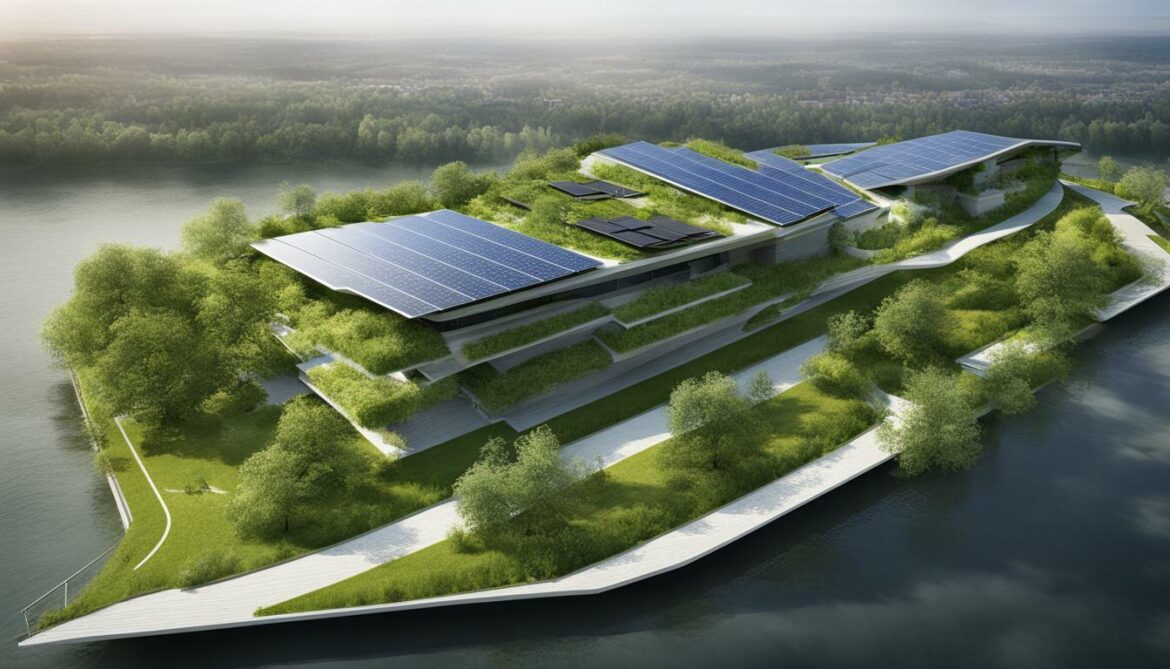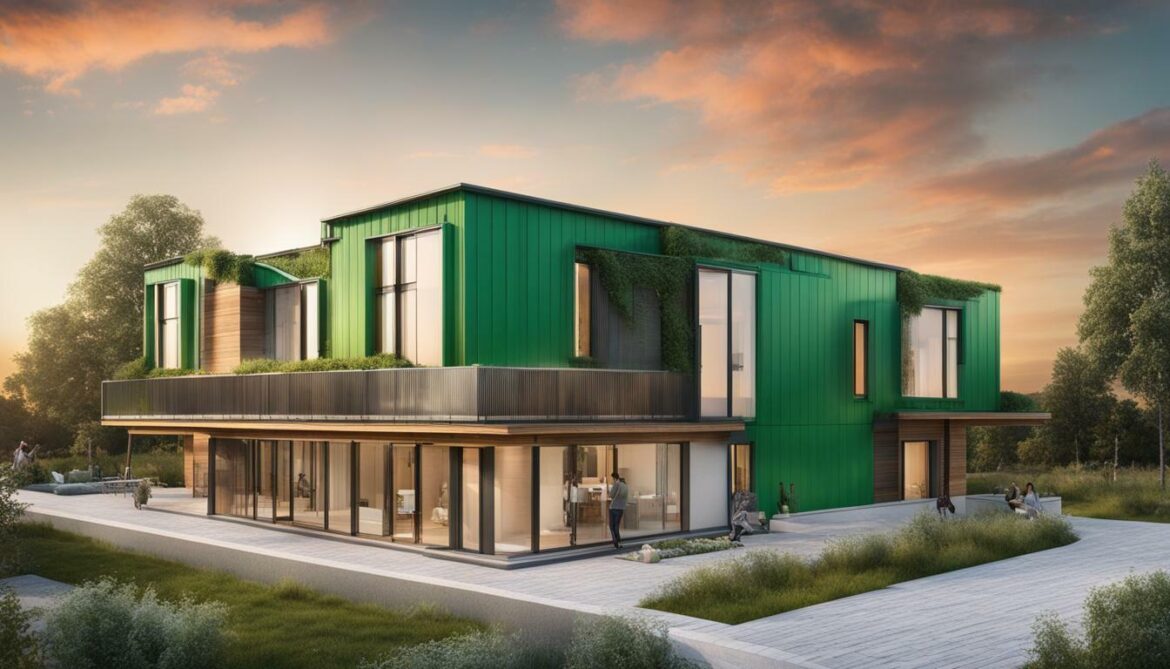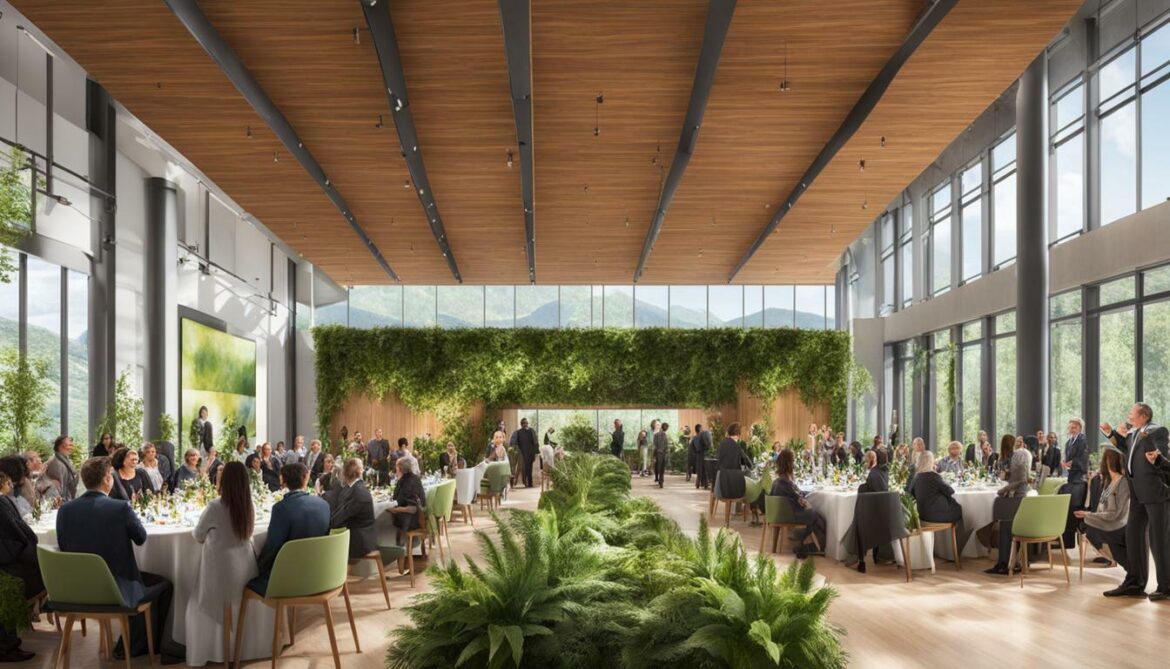Hungary has a rich history of embracing sustainable architecture and environmentally friendly construction practices. From its historical landmarks to modern structures, the country showcases a commitment to sustainable design and eco-friendly construction. The Hungary Green Building Council (HuGBC) plays a significant role in promoting and enforcing green building practices, ensuring a greener future for Hungary.
Key Takeaways:
- Hungary has a strong tradition of sustainable architecture and eco-friendly construction.
- The Hungary Green Building Council (HuGBC) promotes environmentally responsible and profitable construction practices.
- HuGBC contributes to the development of architectural regulations and raises environmental awareness within the industry.
- They share knowledge and innovative practices through training, conferences, and collaboration with higher education institutions.
- HuGBC is involved in various sustainability projects and has a database of Hungarian buildings with green ratings.
By embracing sustainable architecture and eco-friendly construction, Hungary is paving the way for a greener future. Through the efforts of organizations like HuGBC, the country continues to promote environmentally responsible practices and raise awareness about the importance of sustainable design and construction.
The Hungary Green Building Council (HuGBC)
The Hungary Green Building Council (HuGBC) was founded in 2009 as a nonprofit organization to promote sustainable development and encourage eco-friendly building practices. HuGBC plays a vital role in advancing Hungary’s green building industry by developing architectural regulations that support sustainable construction and enforcing environmental awareness within the sector.

Through knowledge sharing and collaboration, HuGBC educates professionals in the field by offering training, conferences, and workshops. The organization also collaborates with higher education institutions to introduce new technologies and innovative practices into the industry.
HuGBC is a member of the World Green Building Council, actively participating in sustainability projects and initiatives. They maintain a database of Hungarian buildings that have achieved green ratings, which they organize building tours for. Additionally, HuGBC contributes to publications and distributes a green newsletter to a wide audience.
The Eiffel Palace office building in Budapest is a prime example of Hungary’s commitment to environmentally friendly construction. It has earned LEED Gold and BREEAM Very Good certifications and was the proud recipient of the WorldGBC Europe Leadership in Green Building Award in 2015. Featuring solar collectors, rainwater harvesting, and energy-saving LED light fixtures, the Eiffel Palace showcases the effectiveness of sustainable practices in the built environment.
HuGBC is dedicated to transforming Hungary’s built environment through sustainable practices and offers various benefits to its members. With their commitment to promoting sustainable development and raising environmental awareness, HuGBC continues to play a vital role in Hungary’s green building industry.
HuGBC’s Contribution to Sustainable Construction
HuGBC plays a crucial role in shaping sustainable construction in Hungary through the development of architectural regulations and promoting environmental awareness. As a nonprofit organization founded in 2009, HuGBC is dedicated to promoting environmentally responsible and profitable construction practices in the country.
One of HuGBC’s key contributions is the development of architectural regulations that support sustainable construction. They work closely with government authorities, architects, and industry professionals to establish guidelines that prioritize energy efficiency, waste reduction, and the use of environmentally friendly materials. These regulations ensure that new buildings and renovations align with sustainable principles, creating a greener and more sustainable built environment.
In addition to regulatory efforts, HuGBC actively promotes environmental awareness within the construction industry. They conduct training sessions, conferences, and workshops to educate professionals about sustainable construction techniques and showcase innovative practices. By sharing knowledge and fostering collaboration among industry stakeholders, HuGBC aims to accelerate the adoption of sustainable building methods and technologies.
Examples of HuGBC’s initiatives:
- Organizing training sessions on green building principles and practices
- Hosting conferences and workshops to share innovative solutions
- Collaborating with higher education institutions to introduce new technologies and sustainable design concepts
HuGBC’s efforts have been recognized both nationally and internationally. They are a member of the World Green Building Council and have been involved in various sustainability projects, including the Budapest bid for the 2024 Olympics. HuGBC maintains a database of Hungarian buildings that have achieved green ratings and organizes building tours to showcase successful sustainable projects.
By actively promoting sustainable construction practices and providing resources and support to industry professionals, HuGBC is driving the transformation of Hungary’s built environment towards a more sustainable and eco-friendly future.

HuGBC actively shares knowledge and fosters collaboration within the industry through training, conferences, workshops, and partnerships with higher education institutions. They believe that by promoting innovative practices and encouraging the exchange of ideas, they can drive the transformation of the built environment towards sustainability.
One of HuGBC’s key initiatives is their training programs, which provide professionals in the construction industry with the knowledge and skills needed to implement green building practices. These programs cover a wide range of topics, including energy-efficient design, renewable energy systems, and sustainable materials. By equipping professionals with the latest information and best practices, HuGBC ensures that the industry stays up to date with the latest advancements in sustainable construction.
In addition to training, HuGBC organizes conferences and workshops that bring together experts, practitioners, and stakeholders to share their experiences and insights. These events provide a platform for networking, learning, and collaboration, fostering a culture of innovation and continuous improvement within the industry.
Partnerships with Higher Education Institutions
HuGBC recognizes the importance of engaging with higher education institutions to drive research, innovation, and the development of new technologies. They collaborate with universities and colleges to introduce sustainable building practices into the curriculum and support research projects that contribute to the advancement of green construction.
These partnerships provide students with the opportunity to gain practical experience and knowledge in sustainable design and construction. By involving the future generation of professionals, HuGBC ensures that there is a pipeline of talent equipped with the skills and expertise needed to drive the adoption of sustainable practices in the industry.
| Benefits of HuGBC’s Knowledge Sharing and Collaboration |
| Access to the latest research and developments in sustainable construction |
| Opportunity to network and connect with industry experts and peers |
| Training programs that enhance professional skills and knowledge |
| Collaboration opportunities to drive innovation and implement best practices |
| Support for research projects that contribute to the advancement of green construction |
Through their knowledge sharing initiatives and collaborations, HuGBC is playing a crucial role in driving the adoption of sustainable practices in Hungary’s construction industry. By empowering professionals and supporting research and innovation, they are contributing to the development of a greener and more sustainable built environment.

Hungary is home to several remarkable green buildings, both historical landmarks and contemporary structures that exemplify sustainable design and innovative green construction technology. These buildings showcase the country’s commitment to environmental responsibility and serve as examples of how architecture can integrate with nature. Let’s take a closer look at some of these noteworthy green buildings in Hungary.
Historical Landmarks
One of the most iconic green buildings in Hungary is the Hungarian Parliament Building in Budapest. Built in the late 19th century, this stunning structure features intricate architectural details and incorporates sustainable design principles. It utilizes natural lighting and ventilation systems to minimize energy consumption, while its rooftop gardens provide insulation and contribute to the building’s overall aesthetic.
Another historical green building worth mentioning is the Castle of Vajdahunyad in Budapest. This fairy-tale castle blends various architectural styles and is surrounded by a beautiful park. The castle’s recent renovations have integrated sustainable elements, such as solar panels and rainwater harvesting systems, making it a prime example of sustainable preservation and adaptive reuse.
Contemporary Structures
In recent years, Hungary has witnessed the rise of contemporary green buildings that embrace cutting-edge sustainable design principles and green construction technology. One notable example is the Eiffel Palace office building in Budapest. This LEED Gold and BREEAM Very Good certified building incorporates features such as solar collectors, rainwater harvesting, and energy-saving LED light fixtures. It received the prestigious WorldGBC Europe Leadership in Green Building Award in 2015 for its outstanding sustainable features.
Another contemporary gem is the Central European University (CEU) building in Budapest. Designed with sustainability in mind, the building incorporates energy-efficient systems, green roofs, and extensive use of natural daylight. It demonstrates how a modern educational institution can prioritize sustainability while providing a conducive learning environment.
These green buildings in Hungary are not only architectural marvels but also symbols of the country’s commitment to environmental stewardship and sustainable development. They inspire future generations of architects, engineers, and designers to prioritize eco-consciousness in their projects, ensuring a greener and more sustainable built environment for all.

HuGBC’s Recognition and Contributions
HuGBC has made significant contributions to sustainable practices in Hungary, as evidenced by their involvement in various sustainability projects, green ratings database, and prestigious awards.
One of the notable sustainability projects that HuGBC has been involved in is the Budapest bid for the 2024 Olympics. Through their expertise in green building practices, they helped ensure that the proposed infrastructure for the Olympics would be environmentally responsible and energy-efficient. This involvement highlights HuGBC’s commitment to promoting sustainable development on a large scale.
In addition to their project involvement, HuGBC maintains a comprehensive green ratings database of Hungarian buildings that have achieved environmentally friendly certifications. This database serves as a valuable resource for individuals and organizations looking to explore sustainable building options in Hungary. Furthermore, HuGBC organizes building tours to showcase these exemplary green buildings, allowing participants to witness firsthand the positive impact of sustainable design and construction.
Recognizing the importance of knowledge sharing, HuGBC contributes to publications and maintains a green newsletter that reaches a wide audience. This ensures that the latest information and innovative practices in green building are disseminated throughout the industry, promoting continuous improvement and growth. HuGBC’s dedication to knowledge sharing is further demonstrated through their collaboration with higher education institutions, where they work together to introduce new technologies and approaches to sustainable construction.
To further highlight their commitment to sustainable practices, HuGBC was awarded the WorldGBC Europe Leadership in Green Building Award in 2015. This prestigious recognition reflects their outstanding contributions to the advancement of green building in Hungary and their dedication to transforming the built environment. The Eiffel Palace office building in Budapest, which earned LEED Gold and BREEAM Very Good certifications, is a prime example of their success. It showcases environmentally friendly features such as solar collectors, rainwater harvesting, and energy-saving LED light fixtures, setting a high standard for sustainable office buildings in Hungary.
Green Building Awards Won by HuGBC
| Award |
Year |
Building |
| WorldGBC Europe Leadership in Green Building Award |
2015 |
Eiffel Palace office building |
Membership with HuGBC comes with numerous benefits, including access to industry events, networking opportunities, and resources for sustainable development. By joining HuGBC, individuals and organizations can contribute to the advancement of green building practices in Hungary and play a part in creating a more sustainable future.

Hungary’s green building history showcases the country’s commitment to sustainable architecture and the positive impact of energy-efficient buildings and green building practices on the environment. The journey towards eco-friendly construction began with the establishment of the Hungary Green Building Council (HuGBC) in 2009. This nonprofit organization has played a crucial role in promoting environmentally responsible and profitable construction practices.
HuGBC has been instrumental in the development of architectural regulations that support sustainable construction and enforce environmental awareness within the industry. Their efforts have led to the implementation of sustainable design principles and the incorporation of energy-efficient technologies in building projects across Hungary. By raising awareness and advocating for green building practices, HuGBC has helped transform the built environment towards a more sustainable future.
In addition to their regulatory role, HuGBC actively shares knowledge and innovative practices through various channels. They organize training sessions, conferences, and workshops to educate industry professionals on the latest advancements in sustainable construction. Their collaboration with higher education institutions further ensures the integration of new technologies and approaches into the curriculum, preparing the next generation of architects and builders to create greener buildings.
HuGBC’s recognition and contributions have been noteworthy both nationally and internationally. They have been involved in sustainability projects, including the Budapest bid for the 2024 Olympics, and have amassed a database of Hungarian buildings that have achieved green ratings. The Eiffel Palace office building in Budapest, a shining example of their efforts, garnered LEED Gold and BREEAM Very Good certifications, earning them the prestigious WorldGBC Europe Leadership in Green Building Award in 2015. This impressive structure showcases a range of environmentally friendly features, such as solar collectors, rainwater harvesting, and energy-saving LED light fixtures.
Membership in HuGBC offers numerous benefits to individuals and organizations committed to sustainable practices in the built environment. From access to publications and a green newsletter reaching a wide audience to building tours and networking opportunities, HuGBC provides a platform for collaboration and continued growth in the field of sustainable architecture and construction. As Hungary continues to prioritize green building practices, the efforts of HuGBC and the country’s rich green building history will serve as a source of inspiration and guidance for future projects.
FAQ
What is the Hungary Green Building Council (HuGBC)?
The Hungary Green Building Council (HuGBC) is a nonprofit organization founded in 2009 to promote environmentally responsible and profitable construction practices in Hungary.
What is HuGBC’s role in sustainable construction?
HuGBC is involved in the development of architectural regulations that support sustainable construction and enforce environmental awareness within the industry.
How does HuGBC share knowledge and innovative practices?
HuGBC shares knowledge and innovative practices through training, conferences, and workshops. They also collaborate with higher education institutions to introduce new technologies.
Are there any notable green buildings in Hungary?
Yes, Hungary has several notable green buildings, including historical landmarks and modern structures showcasing sustainable design and green construction technology.
What sustainability projects has HuGBC been involved in?
HuGBC has been involved in various sustainability projects, including the Budapest bid for the 2024 Olympics. They also maintain a database of Hungarian buildings that have achieved green ratings.
Has HuGBC received any recognition for their work?
Yes, HuGBC’s efforts have been recognized, including the Eiffel Palace office building in Budapest winning the WorldGBC Europe Leadership in Green Building Award in 2015 for its environmentally friendly features.
What is the mission of HuGBC?
HuGBC is dedicated to transforming the built environment through sustainable practices and offers various benefits to its members.
Source Links























Post comments (0)